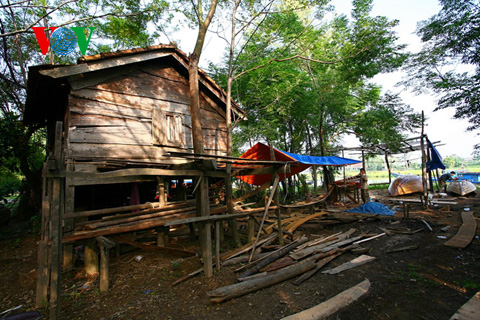Wooden Houses: Preserving a Culture

16 years ago, a carpenter with nothing but a dream and relentless passion to restore old wooden houses quit his job as a local officer, borrowed money, fixed one disrepaired house, and the rest is wooden house history, or house-tory if you may, so to speak.
Le Van Tang belongs to a third generation carpenter family which was in fact famous in a carpentry village called Kim Bong Carpentry Village. The community had over 400 wooden houses that were more than 150 years old and just slowly wasting away either due to bad weather conditions or lack of money to preserve them. Restoring an old or broken wooden house cost about five to six times more than building a new concrete house so owners most likely chose the latter, to the utter disappointment of Tang. This made him decide to borrow two million dong and buy a house in Binh Nam Commune to restore to its original, or even better, beauty.
His hard work and dedication paid off when after fixing the house along with two helpers, three men approached him and offered to buy the restored house for six million dong. Tang refused at first, even after being offered to double the original offer. He finally gave in when the same people came back the next day and offered a whooping VND28 million for the said structure, overwhelmed that his work could value that much.
Tang used the money he earned to buy other wooden houses in both dilapidated and good conditions, travelling to both near and far areas in search of potentials. When he discovered well-preserved wooden houses, he asked the owner's permission to study their homes, including replicating elaborate designs and even learning about its history. When he did see a wooden house in disrepair, he was willing to pay a lot of money for it because he knew he would be able to use part or parts of it as materials for other wooden houses to fix. In fact, he would even buy one whole house even for a single material that he needed from it to save another.
Tang's talent, passion and experience has honed him into an expert in the craft, even being able to tell the age or origin of a wooden house after it has been destroyed. But according to him, even a wooden house rated “well-restored” is only equivalent to 50%-60% actual restoration because workers today are nothing compared to the incredible talent and passion of artisans in the old days. Tang's team is a 12-people group composed of craftsmen and sculptors, including his son. He has also started a workshop for 300 local carpenter and sculptors from Van Ha and Kim Bong villages in Quang Nam Province to encourage people to get into the art of preserving wooden houses.
Since 1997, Tang and his team has restored many wooden houses from the North to the South. One of Tang's greatest work is replacing the rotten frame of a temple for Ong Ich Khiem, a general under the Nguyen regime in the period 1831-1884. The past officer's family Ong was so impressed with Tang's work because he changed the entire frame that had gotten so disintegrated without having to remove the roof and tiles of the structure. But one work he considered among his toughest was fixing a four-storey, 140-year old French-style wooden house in 2000 which wasn't really a difficult job per se, but became one because of the owner's meticulous demands. Owned by Si Hoang, an ao dai designer, he required specific details on the restoration process that it took 40 carpenters and six months to finish the job. The house now stands at 36-38 Ly Tu Trong Street, District 1, Ho Chi Minh City.
Tang's work is no easy job at all. It's a long and tedious process which takes months and even years to finish. He faces difficult choices like having to move a house from its original location to a new one, but something that he risks doing to be able to salvage the building than watch it waste away to time and/ or inattention. Convincing an owner to sell his/ her house alone could also take years to accomplish, usually agreeing only when the house is so dilapidated that they think they won't be able to save it anymore or can't afford the cost. Tang travels to even remote places to find or fix even minute details. He doesn't mind being paid less as long as he is able to preserve a wooden house. Moreover, his work even surpasses the technical part as he goes out of his way to attend even the housewarming ceremony after a house is restored, treating his clients as friends and family as well.
Tang and his team's passion and dedication to their work are far stronger than any challenge they may encounter, seeing wooden house restoration not just as a job but pure love for the art, that is why their success is inevitable in the end.









